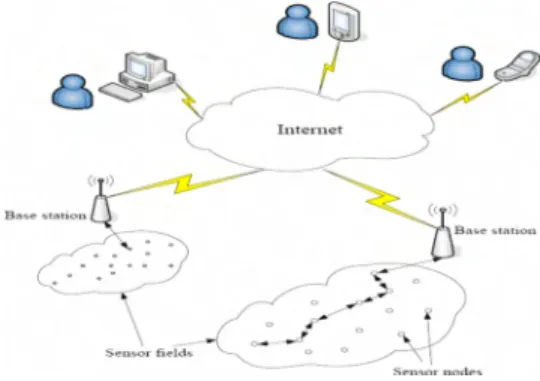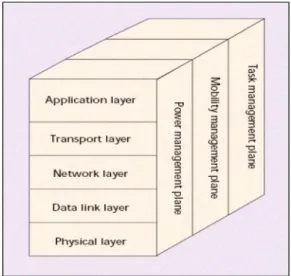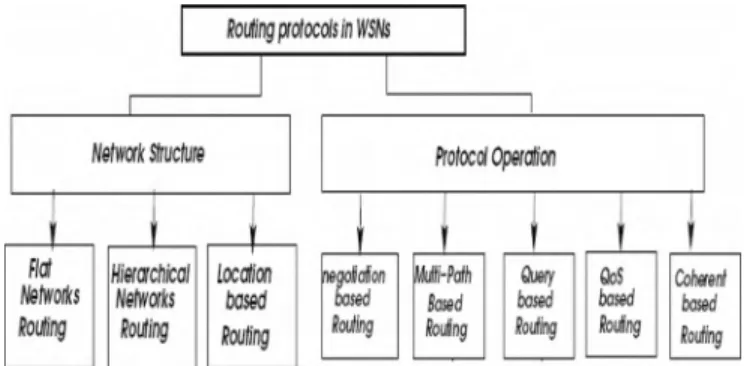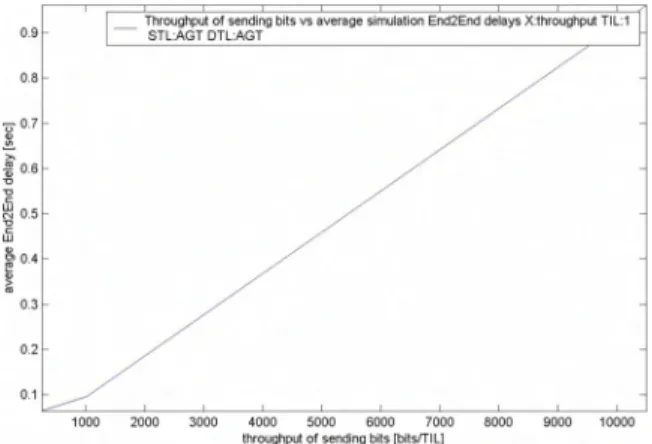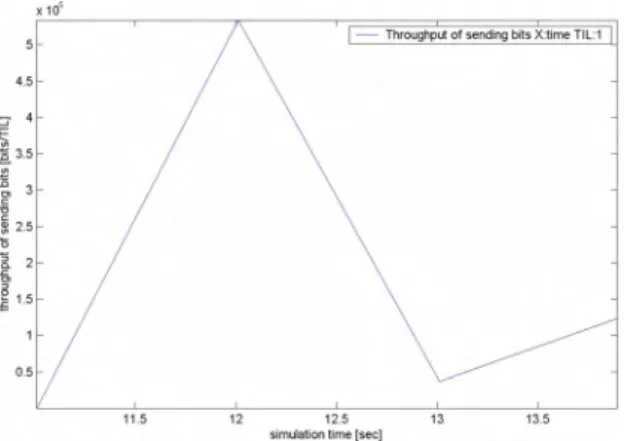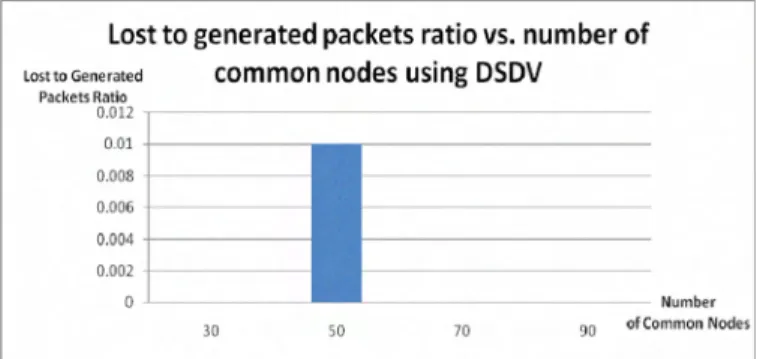Routing in Wireless Sensor Networks
Fig. I . WSN architecture with Internet access ~~
~
. .~
\
-S", n<,.o.- 1, ,,,ld,,
Rachid Ennaj i
School of Science and Engineering AI Akhawayn University in Ifrane
Ifrane, Morocco r.ennaj@gmail.com
Abstract-A sensor network is a system that consists of thousands of very small stations called sensor nodes. The main function of sensor nodes is to monitor, record, and notify a specific condition at various locations to other stations and end users . Eventually, this presents a wide range of applications that motivates research in sensor networks. The communication among nodes is done in a wireless fashion, and thus, the name of wireless sensor networks. This paper studies wireless sensor networks throughout a number of selected articles, papers, and online resources. A good understanding of sensor networks and wireless communications is the main learning outcome of this study. Specifically , the research concentrates on routing in sensor networks, and is supported by a simulation of a sensor network application performed with Network Simulator. Before simulating, a careful study of available simulators is conducted as well. Once the tools are available, implementation and simulation follows. The simulation focuses on finding the best routing protocol, in terms of delay and dropped packets, as a complement for the study. The protocols studied are AODV and DSDV. The interpreted results clearly show that DSDV is the best protocol for our simulation. The research concludes with recommendations for future work.
Index Terms-Wireless Sensor Networks, Routing, Simulation, Network Simulator.
I. INTROD UCTIO N
The inventions and the usage of smaller chips in the newest technologies , such as POAs, GPS devices, RFIO technology , etc confirms Moore's Law [I], and thus, this imposes new interesting questions and challenges in different areas of computer science. Questions such as: how to efficiently control the safety of forests from fires?
How to achieve efficient surveillance for military
purposes? How to efficiently study habitat in a certain region? Questions like these have posed challenging questions for research in WSNs. Sensor networks represent an opportunity to implement a number of interesting
applications: Military applications, context-aware
computing, environment al monitoring, and industrial
sensing and diagnostics.
II. O ErINITIO N AND CHAL LENGES A. Definition
A sensor network is a system that consists of thousands of very small stations called sensor nodes [2]. The main function of sensor nodes is to monitor, record, and notify a specific condition at various locations to other stations.
Mohammed Boulmalf School of Science and Engineering
AI Akhawayn University in Ifrane Ifrane, Morocco
m.boulmalf@aui.ma
Conditions can be temperature, humidity, wind, pressure, vibrations, sound, and so many more. In order for such nodes to sense, compute and communicate, they should rely on a battery to stay active. Eventually, the low-power circuit and networking technologies today make such sensors rely on 2 AA Batteries and can stay alive for up to
three years with a I% low duty cycle mode [2]. With
wireless communications, the thousands of sensors within a network can communicate through various channels in a wireless fashion. Along with these components, a base station is required in the architectur e.
Several features make wireless sensor networks special in comparison to other categories of computer networks. The most important feature is the hardware; the sensor nodes have small sizes and have the ability to transfer data at low energy, as we are sending only text. Furthermore, sensor networks are subject to more severe power constraints than POAs, mobile phone, or laptops. The whole network is usually under the administration of one controller, the base station. Finally, sensors within a network, unlike in other networks, gather and send data that specifically concerns a particular application [7]; hence, interaction between the application layer and the other layers is needed.
B. Structure
As mentioned above, the most essential part in WSNs is the sensor nodes. A number of sensor nodes have been developed by several research groups such as UCB, Intel, MIT Media lab, and many more. Advances in hardware such as
System-on-chip allow having all the components of a
computer within the sensor nodes. Therefore, this makes a classic architecture ofa WSN as follows [2]:
The base stations in this architecture act as intermediaries between the sensors and the end users (Fig. I). This is, hence, why they are also called sink nodes as the information sensed by the nodes are all directed to the base stations after
following specific routing standards. The main functionality of a base station is to act as a gateway to another network, and is a powerful data processor and storage center [6].
Besides , a layered approach is adopted in sensor networks as well. The sensor network protocol stack consists of the traditional layers, and of a Power Management layer , a Mobility Management layer, and a Task Management layer (Fig. 2). This protocol stack is developed so as to increase the level of awareness of the sensors in order to meet the requirements and challenges in WSNs.
/
/
/
/
/
/
s:
~"""
0 3 A p p li catio n l ay e r -0 ~.g '""" '" ~ (C g '" !!: 3 3 ""'"
Tr a n sp ort l a ye r'"
~ '" (C ""'"
"'C '" g w (C "" !l1 ~ '" N e t w or k l ayer :;'"
"2-a
'"
"'C~ V
D a t a l i n k l ay e r zriiiV
Ptl ys ica l la y e rFig. 2 .Sensor Network Protocol Stack A. Challenges
The discussion in the previous sections brings us to the topics of research in WSN that are [3]: architecture, routing and mobility, distributed signal processing, storage and data retrieval , actuation, simulation, and security. In the next sub-sections , a brief overview of these challenges is presented.
Architecture: Designing an efficient architecture with
minimum energy consumption is an important hardware
question in WSNs, and has eventual compromises.
Compromises may include size, capacity, cost, and speed. The studies in this field today have ended up with a two or three tiered architecture. As showed in figure 4.1, the tiers go from the wired, server-based Intern et tier, to the hardware tier with platforms such as TinyOS [3]. Thes e platforms are what actually allow computations and storage at the level of the sensors with low duty cycle mode.
Routing and mobility: Routing in sensor networks differs from the one in the traditional IP Networks. Unlike the Internet Protocol Suit adopted in the TCP/IP architecture,
other routing systems have been developed for sensor
networks. In fact, getting data from all the thousands of sensors eventually results in the receipt of irrelevant and redundant data from nodes, which is definitely not efficient at the level of storage and energy. Therefore, instead of having
the routing system acting as a transport mechanism
independent from the application, clearly more processing is needed at the level of routing. The latter is also called in-network processing. This system is supported by the directed diffusion routing, one of the early developed data driven routing systems [3]. Other challenges than data aggregation
exist in WSNs; such as: quality of service, coverage,
connecttvity, transmission media , scalability, network
dynamics, and so forth [4].
More about routing protocols used in wireless sensor networks is discussed thoroughly in the later " Routing" Section.
Distributed Signal Processing: Signal processing represents an important and fundamental part of the low-level layer in WSNs. Signal processing provides base stations and users with location, signal identification, etc [3]. Basically, the research in DSP in WSNs is concentrated on retrieving the best signal taking into consideration the constraints in a sensor network [3].
Storage and Data Retrieval:The usage of a traditional central database to store the huge number of raw data sent by sensors is also not a suitable approach in WSNs. This is because many different variables are added to the equation. The use of wireless channels, the reliability and availability of sensor nodes , as well as energy constraints lead to a new approach for storage and data retrieval [3]. The new approach would be to have data stored locally within the sensors , and thus , these sensors can be queried for data retrieval. Of course, for efficiency in the system, processing should be undergone within the nodes.
Actuation: Actuation means the act of putting into motion. This, actually, represents one of the challenges that make
WSNs a powerful technology. It can first, allow pointing
cameras and antennas to the right direction, as well as repositioning of the sensors according to the change in the
environment. Second, it'll allow putting action into the
environment throughout sending sounds , opening valves , or strengthening beams [3].
Security: Sensor nodes communicate important private data in most WSN applications, and thus, security is a crucial part in such systems. In fact, sensors are subject to changes from attackers in the hardware that may eventually change the behavior of the sensors, and thus, change the results [3]. Consequently, one way to consider in ensuring data security would be to use key encryption; however, this is not practical
in sensor networks again for efficiency and resource
constraints [6]. Hence, as in-network processing is needed this will change the whole security approach from the tradition one in Internet networks. However, several other similar points are considered in WSN security [6]:
• Data confidentiality
• Data authenticity
• Data integrity
• Data freshness
• Robustness and survivability
III. RO UTING PROTOCOLS
A. Classification
A number of limitations exist in routing in sensor networks, and have been discussed in a previous section. Briefly , the major limitations are: dynamicity, high power consumption, low bandwidth, high error rates , and high delay [17]. Research [3] has theoretically categorized routing protocols for Wireless Sensor Networks according to the existing limitations as follows (Fig. 3):
Network Structure:
• Flat networks routing: equal functionality for all nodes
• Hierarchical networks routing: different functionality
for a number of nodes
• Location based routing: the data is routed depending on
the nodes' positions Protocol Operation:
• Negotiation based routing: uses data descriptors to
suppress duplicate data to be sent to the next sensor
• Multi-path based routing: more than one path is used
for performance especially at the level of fault tolerance
• Query based routing: a specific query is spread among
nodes that respond accordingly
• QoS based routing: compromise certain features
(bandwidth, energy, etc) over quality
• Coherent based routing: perform in-network processing
After the deployment of a WSN, typically ad-hoc, the sensors can not only answer a query, but also give information about location, speed, or size of a specific phenomenon [3]. However, how specific is the information given by the sensors? How close these sensors are to the phenomenon? Such questions call for automatic localization of nodes as areas of WSNs are typically large.
The Global Positioning System (GPS) is one solution to this challenge. However, this technology will not be practical in indoor applications, for example, as a line of sight is required for GPS [3]. Besides, a number of research and schemes have been developed thanks to research [3].
B. Ad-hoc Routing Protocols
A widely accepted and routing-specific classification [18] states that the nature of wireless sensor networks makes routing fall under the ad-hoc category . Ad-hoc routing represents a set of standards defining how nodes in a network route packets between devices in Mobile Ad-hoc Networks (MANETs). In wireless sensor networks, nodes communicate directly with a base station which explains its MANET nature. Therefore, continuous mobility disturbs already set up paths, and thus, this often leads to reestablishment of the paths with the sink node [17]. All these problems along with the most important aspect, that of energy, make developing routing protocols for wireless sensor networks a challenging and hot topic in sensor networking.
MANET routing protocols are categorized into three types [18]:
Flat Hiercxchicaf toeation Networks Networks based Routing Rotting Roofing Fig. 3 . WSN routing protocol taxonomy
Pro/oedOperation QJeI)' based Rotiing QoS based Roulng Coherent based Routing
• Proactive/Table-driven routing protocols: A routing
table describing all node paths is maintained at each node.
• Reactive/On-Demanding routing protocols: A route
discovery mechanism is created as asked for.
• Hybrid routing protocols: A combination of both
above categories
MANET Routin g Protoc ol s
Fig. 4 . MAN ET routing protocols classification
We discuss the two popular routing protocols (DSDV and AODV) from both the above categories that are used in the simulation in the following section .
• 10.3.1 Destination-Sequenced Distance-Vector (DSDV)
Destination-Sequenced Distance Vector (DSDV) [18] is a routing algorithm that focuses on finding the shortest paths. The protocol is based on the bellman-ford algorithm to find the routes with improvements. The latter algorithm is very similar to the well-known Dijkstra's algorithm with the support of negative weights. DSDV falls in the proactive category of routing protocols; hence, every mobile node maintains a table containing all the available destinations, the number of hops to reach each destination, and a sequence number. The sequence number is assigned by the destination node its purpose is to distinguish between old nodes and new ones. In order for the nodes to keep track of moving other nodes, a periodic message containing a routing table is sent by each node to its neighbors. The same message can also be sent if significant change occurs at the level of the routing table. Therefore, the update of the routing table is both time-driven and event-driven. Further discussion can be done for better performance , such as not sending the whole table (full dump update), but only the modified portions (incremental update). The motivation behind it is to be able to update the rest of the network through one packet. This means that if the update requires more than one packet, a full dump is probably a safer approach in this case.
• 10.3.2 Ad-hoc On-Demand Distance Vector (AODV)
AODV routing [18] falls under the reactive routing protocols in that it discovers routes once demanded via a route discovery process. The protocol uses route request (RREQ) packets sent by the sender node and circulating throughout the network. Each node in the network rebroadcasts the message except the sink node. The receiver replies to the RREQ message with a route reply (RREP) packet that is routed back to the sender node. The route is then cached for future reference· however in case a link is broken, a route error (RERR) pack;t is sent
t~
the sender and to all the nodes as well so as to initiate a new route discovery. To maintain routing information, AODV usesa routing table with one entry for each destination. Thus, the table is used to propagate RREP to the source node. AOOV also relies on time, which means that if a routing table is not used recently, it will expire. Moreover , once a RERR is sent, it is meant to warn all nodes in the network; hence, this makes it very efficient to detect broken paths.
IV. SIM ULATIO N
The two main approaches to study whatever topic in a scientific method are to either experiment or to simulate. Simulation is widely used in studying computer networking in order to save time and money. This is especially true in wireless sensor networks as hardware and space represent a major component for the success of the research. Simulators will help researchers predict the behavior of a network taking into consideration all the necessary network components. Besides, simulators allow the use and the development of new protocols in an application. Today, a number of protocols are already made available by a number of simulators , and thus, it adds to the advantages of using simulation. However, a number of difficulti es face study and research especially in the area ofWSNs
The major problem is the availability of the right software
to simulate. A number of simulators with different
architectures and services are available for a great number of purpos es. Consequently, defining the best simulator solely depends on the goal of the research. In the case of sensor networks , the number of simulators is limited as several components, such as energy, power, mobility, and sensing are needed for accurate results. Many simulators can be found in [5]. In this study, exactly four selected simulators were considered.
Another problem in simulating sensor networks is the scalability and reliability of the results of a simulation [5]. Higher density and number of nodes are important issues and should be made available by simulators. The matters mentioned above are only a small portion of all the problems that should be considered when using simulators. In this research , Network Simulator is used with the Mannasim Framework for sensor networks extension.
• Antenna: Omni directional
• Energy model: Battery
• Number of sink nodes: 1
• Number of clusters: 2
• Sensing power: 0.015 J
• Processing power: 0.024J
• Bandwidth: 288 Kbps
Other parameters such as routing protocol, routing queue length, number of common nodes, and sensing area have variable values according to each simulation.
Two simulation scenarios were performed during this study. A description of each scenario is described in table 1:
Table I : Simulation Scenarios
Simulation Simulation # 1 #2 Routing queue 50 50 length (cells) Common 30,50,70,90 30,50,70,90 nodes
Routing AOOV OSOV
protocol
Sensing area 120*120 120*120
(m)
VI. RESULTS AND DISC USSION
In order to interpret the trace files, Trace Graph 2.02 is used in this capstone. End-to-end delay, packet behavior, and throughput are the main metrics for our performance study. This section treats results of each scenario
A. Simulation #1
Using AOOV, we notice similar behavior in the graphs below (Fig. 5 & Fig. 6), however, there is an increase in both the delay and the throughput as the number of nodes increases. A summary of the values vs. the number of nodes is shown in a later section.
Fig. 5 . E2E delay vs, throughput (bits/s) for AODV with 50 nodes V. SIMULATION MODEL
The simulation conducted in this research uses the
Mannasim framework simulation application under ns2-29.
The simulation represents an application that senses
temperature. Packets are sent to the sink node when the sensed temperature is above25°.
This study focuses on comparing the two routing protocols OSOV and AOOV in order to find the best proto col for the studied scenario. The Oynamic Source Routing Protocol (OSR) was meant to be used as a third protocol for study; however, the OSR model is broken in NS, and thus, is not recognized at compile time.
A number of parameters are set for common nodes as follows:
• Channel: Wireless
• Propagation: Two ray ground
• MAC protocol: 802.11
• Routing Queue: Drop'Tail
0.9 0.6 '0°.7 ! ~ ~ 0.6 -c ~0.5 &0.4
i
0.3 0.2 0.1Throughput of sending bits vs average simulation End2End delays X :throughpul T IL:1 STL :AGT DTL:AG T
1000 2000 3000 4000 5000 6000 7000 8000 9000 10000 throughput of sending bits [bilstrIL]
End-to-end delay vs. number of common nodes usinf AODV
- Throughputof sending bits X:time TIl: 1
/"
/
/
~
... 4.5 35 2.5 1.5 2.5"'"
II) 2 .:'"
'"
1.5 OJ"
"
c q> ~ 0 .5"
c w o o 20 40 60 80 1000.5 Number of common nodes
11.5 12 12.5 simulation lime [sec)
13 13.5
Fig. 9 .End-to-end delay vs. number of common nodes using AODV routing Fig. 6. Throughput (bits/s) vs. Time for AODV with 50 nodes
B. Simulation #2
Similarly, We notice the same behavior in the graphs below (Fig. 7 & Fig. 8) using DSDV. With fluctuating values in delay and an increase in throughput as we increase the number of common nodes in the network.
_ ~~~~~~Do;~:~~~gbits vs average simulation End2End delays X:lhroughpul T ll :1 0.016 ~0.014 s: i:' ~ ~0.012 ~ 8, 0.01
i
0.006From the graph in Fig 9, the end-to-end delay fluctuates between 0.3s and 2.3s when using AODV routing protocol.
End-to-end delay vs. number of common nodes using DSDV 0.009 0.008 o
.r-«:
'"
0.007 II)/ '
---....
c ';' 0.006 ..,/'"
OJ 0.005"
-g 0.004'"
6 0.003 ~ 0.002 w 0.001 0 30 50 70 90Number of common nod es
Fig. 10 .End-to-end delay vs. number of common nodes using DSDV routing
fi g. 7 .E2E delay vs. throu ghput (bits/s) for DSDV with 70 nodes 1000 2000 3000 4000 5000 6000
throughput of sending bits [bilsITl l]
7000 8000 From the graph in Fig 10, the end-to-end delay fluctuates
between 0.005s and 0.008s when using DSDV routing in our simulation.
Lost to generated packets ratio vs. number of
Lost t o Generat ed common nodes using AODV
POCke
tS
R
o
t.;8
9_
0.08 0 .D7 0.06 - - - -0.05 0 .04 - - - -0.0 3 0.02 - - - -o.o~ - Numb er 30 50 70 90 of Ccmmcn Nodes- Throughput of sending bits X:lime Tll :1
1 4000 1--~---'7\---,r=~=;==;=.=oc=c=~==" 12000 ~10000 ~
"
~ 8000 "!i '0 6000 ~t
4000 ;;fig. 8 .Throughput (bits/s) vs, Time for DSDV with 70 nodes C. Comparison
In this section we summarize the findings into graphs, and discuss the comparison between the protocols:
2000
11.5 12 12.5
simulation time [sec)
13 13.5
Fig. II .Lost to generated packets ratio vs. number of common nodes using AODV
Fig. 11 shows that the rate of packets lost go from 7% to less than 5%. This is regarded as a high percentage, however , as we are only sending text, it may be acceptable in this kind of applications.
Fig. 12 .Lost to generated packets ratio vs. number of common nod es using AODV
In the case of DSDV routing (Fig 12), less packets are lost except when using 50 common nodes. Still, it is only 1% which is lower than in the case of AODV .
R EFER ENC ES
introducing mobility can be an interesting next step for a future paper.
[I] William Stallings. Computer Organization and Architecture Designing for Performance, edition six. Pages 30-44
[2] Introduction to Wireless Sensor Networks.
http://www.worldscibooks. com/comps ci/etextbook/6288/6288 _chap I pdf on October8. 2008
[3] Jeremy Elson, Deborah Estrin. A Bridge to the Physical World. Center
for Embedded Networked Sensing. University ofCalifornia, Los Angeles
[4] Deepak Gane san, Alberto Cerpa, Wei Ye, Yan Yu, Jerry Zhao, Deborah Estrin. Networking Issues in Wireless Sensor Networks
[5] David Curren. A Survey of Simulation in Senso r Networks. University
of Binghamto, New York
[6] Mayank Saraogi. Security in Wireless Sensor Networks. Departm ent of
Comp uter Science, University of Tennessee, Knoxville
[7] L. Guibas , F. Zhao. Wireless Sensor Networks: An Informati on Proces sing Approach.
[8] The Network Simulator - ns2. http ://www.isi.edu/nsnam /ns / on
November 18,2008.
[9] About GloMoSim: Global Mobile Information Systems Simulation Library. http ://pc/.cs.lIc/a.edli/pr o;ects/gl omosim/ on November 18, 20 08 [ 10] Network EngineeringINetwork OperationsINetwork Planning.
http://w ww.opnet.com/soilitions/netw ork plann ing operations/ on November22,2008
[II] SensorSim: A Simulation Framework for Sensor Networks.
http://nesl.ee.uc/a.edll/pro;ects/sensorsim/ on November22,2008
[ 12] NS by Example, WPI: Worcester Polytechnic Institute.
http://nil e.wpi.edll/NS/ on November22,2008
[ 13] OTcI - MIT Obj ect Tcl.
hftp ://bm rc.berkeley.edll/research/cmt/cmtdoc/otc// on October 12, 2008
[14] Marc Greis' Tutorial fo r the UCB/L BNL/V INT Network Simulator
"ns,hftp://w ww.isi.edll/nsnam/ns/tut orial/ on October25,2008
[15] MannaS im Framewo rk - Ma in Page.
hftp://w ww.mannasim.dcc.lIting.br/ on November2,2008
[16] Network Simulator NS-2 trace files ana lyzer - Tracegraph .
hftp ://www .tracegraph com/ on Octobe r 12, 2008
[17] Jamal N. AI-Karak i, Ahmed E. Kama l Routin g Techni ques in Wire less Sensor Networks: A survey. Dept . of Electrical and
Computer Engineering at Iowa Sta te University
[18] G Santhos h Kumar. Mob ility Issues in Wireless Sensor Networks.
Department ofComputer Science at Cochin Uunivers ity ofScie nce &Technology
[19] USC Research on Mobility Modeling and Ana lysis.
hftp://nile.lIsc.edli/important/ on November26,2008 90 70 - - - Number of Common Nodes 50 30 D. Discussion
Now we can easily conclude that the best routing standard in our simulation is the DSDV protocol. End-to-end delay and packet loss are the major metrics for this performance study. Clearly, DSDV wins over AODV in our simulation. The high end-to-end delay when using AODV is due to the protocol's On-Demand nature. The route discovery phase consumes relatively more time if compared to the DSDV protocol. Moreover , the cached routing tables maintained in the AODV expire, and thus, re-discovery of routes is always necessary and time consuming. On the other hand, DSDV does not process time in routing since it does not require a discovery mechanism, and mobility is not an issue in our simulation. Besides, the increased time processing also affect energy consumption at the level of the nodes. This drastically affects the life duration of the nodes, and hence, is a serious performance factor to consider as well.
Therefore , DSDV is definitely the best routing protocol to use in our simulation.
VII. F UTURE WORK
This research represents the starting point for a further research in wireless sensor networks as there is still a huge number of other aspects can be further studied. As this paper treats routing protocols , mobility is an issue that can be further
considered to continue in this project. I have started
integrating mobility in my simulation , however , due to time limitations, several difficulties prevented the pursuit of this study.
I have used the IMPORTANT framework [19] developed by the University of Southern California to integrate mobility. This framework presents a number of models that generate
node locations for ns-2 simulations. The models made
available by IMPORTANT are:
• Random Waypoint (RW) model
• Reference Point Group Mobility (RPGM) model
• Freeway Mobility (FW) model
• Manhattan Mobility (MH) model
The script generator is free for download in [19]. I had been able to generate node locations according to the RPGM model, however, integration to the Mannasim framework requires more time I could not afford. Therefore, studying and
Lost to generated packets rat io vs. number of
l ost to Gen erated common nodes using DSDV
PacketsRatio 0.0 12 , -0 .-01+ -0.008+ -0.006+ -0.004+ -0.002+
